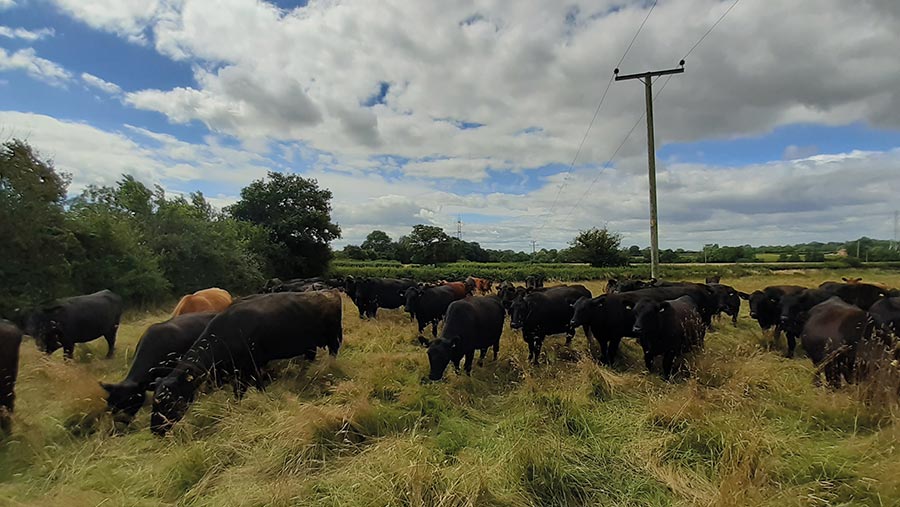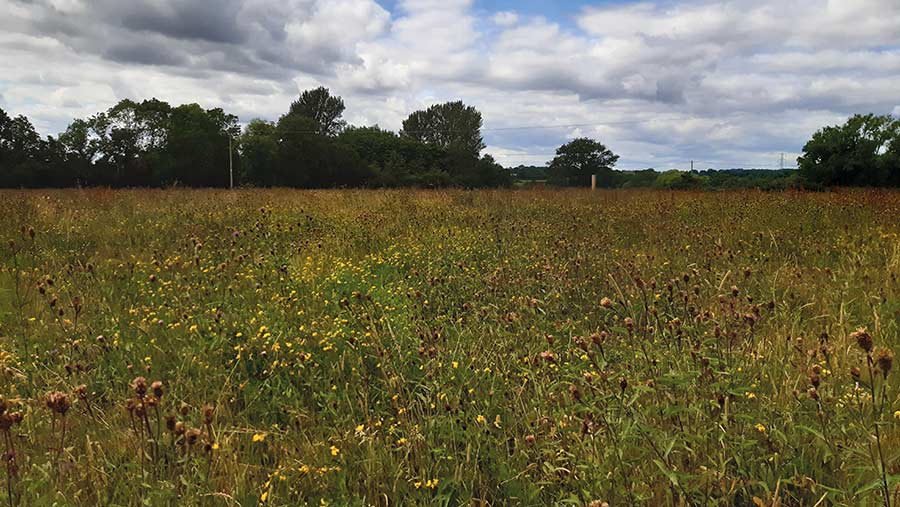8 steps to get started with regen grassland management
 Cattle mob at
Phepson Farm © Helen Brothwell
Cattle mob at
Phepson Farm © Helen Brothwell A shift towards regenerative and more holistic grazing systems is enabling farmers to build greater resilience to fluctuations in weather patterns and market prices by working more closely with nature and reducing interventions.
Regenerative grazing involves higher-intensity, short grazing periods with long resting times in-between, using a system of paddocks.
It keeps the sward height high and encourages regrowth and development of plant and root systems, which also improves soil microbiology and function.
This type of management helps to improve soil condition, biodiversity and livestock health, and maintain steadier financial margins against the backdrop of a reduction in subsidy payments and increasing input costs.
See also: Farmers Weekly Podcast Episode 63: Groundswell – does regenerative agriculture work?
We spoke to four farmers, including one with a consultancy role, to get advice on how to get started with regenerative grassland management.
Expert panel
- Rob Havard farms at Phepson Farm and is an ecology consultant managing 404ha (1,000 acres) of rented or contract-farmed land in Worcestershire, with about 150 pedigree cattle plus followers
- Russ Carrington is manager of Knepp Regenerative Farms, and former general manager of the Pasture-fed Livestock Association. He is in the first year of regenerative grazing on 63ha (156 acres), initially with 25 traditional Sussex cattle and calves, plus 50 Longhorn heifers on a B&B arrangement during the summer. Grazed area and livestock numbers are planned to increase towards full stocking potential
- Wojtek Behnke manages Aqualate Estate in Shropshire. Lleyn sheep and Northern Dairy Shorthorn cattle are mob-grazed on 80ha (200 acres) with horses, occasionally.
- Richard Tustian has been a shepherd in Oxfordshire managing 1,500 breeding ewes, about to return to family partnership on mixed arable, beef and sheep farm totalling 200ha (494 acres) on the Northamptonshire border. Of this, 40ha (99 acres) is permanent pasture and 10ha (25 acres) is herbal leys, currently running 250 breeding ewes and 25 suckler cows
1. Talk to others
- Speak to others who are already managing grassland regeneratively and visit their farms.
- Join discussion groups, pasture-fed livestock forums, WhatsApp groups, podcasts, and events such as Groundswell to ask questions.
- Take inspiration and learn from other farmers, but adapt what you do to meet your own objectives.
2. Plan, observe and adapt
- Set out some overall objectives for your farm, which can then be used to guide day-to-day decision-making. These might include growing animals and producing food to improve the ecological habitat or soil condition.
- Create a grazing plan for the year – this will help you decide which areas stock will graze, and give an idea of the expected forage production, divisions, and shifts required. However, also accept you will need to continually adapt based on regular observations.
- Take time daily to observe grassland and livestock and make decisions based on what you actually see happening in your field.

Species-rich pasture, established initially with a grant © Helen Brothwell
3. Consider your grazing management
- Start in spring and rest half the area, letting the grass grow to about knee height before grazing. Then rest the sward again. Even in a year with poorer growing conditions, grass will grow when it is rested.
- Put all animals into a single group to increase their effectiveness in trampling the sward and to enable adequate rest periods. It is also more time-efficient. Mixing cattle and sheep can assist with parasite control, too.
- As a rule of thumb, allow the stock to eat one-third, trample one-third and leave one-third for regrowth. No more than 50% of biomass should be removed by grazing, otherwise it starts to damage the root mass. The aim should be to have the same biomass below ground as above.
- Move stock every one to three days. Four days should be the maximum on one paddock, otherwise animals start to eat the regrowing plant.
- Rest paddocks for at least 25 days, depending on the time of the year, to allow grass regeneration. Rest periods can be as long as two or three months.
- Invest in electric fencing to create grazing paddocks.
- Where there are no water troughs, install standpipes in the middle of each field. Use a length of overground 20mm pipe and a portable trough that can be moved with the stock.
- Once fences are set up, it typically takes 15-20mins each time to move the fence and check livestock.
4. Establishing pasture
- Aim to create a permanent pasture with a mix of competitive grasses and introduce a variety of beneficial species over time that complement each other.
- Include legumes to fix nitrogen and introduce herbal leys to further increase the overall diversity of species. This will improve soil biological function and structure, extending the growing season and helping unlock more of the existing minerals in the soil.
- Cocksfoot and tall fescue, for example, can put down 2m-long roots, improving the soil’s ability to cope with both drought and high rainfall. Meanwhile, red fescue and yarrow roots have a matted structure nearer the surface, which helps hold the soil together, improving aeration and micro-organism activity. It can also help support livestock on the ground over winter.
- Herbal mixes can be direct-drilled into existing pasture or on former arable land. Another option is to try simply resting pasture. This will allow self-seeding over time for species from the natural seed bank to re-establish.
- Consider bale feeding hay from a species-rich field, which allows cattle to tread in seed and introduce more species to the ley.
5. Animal health
- Leaving the sward high (a minimum of 10cm) and moving animals off pasture before worms can be picked up reduces worm burden and, while faecal egg counts should still be carried out, livestock may not need treatment for worms.
- Limiting the use of wormers will support dung beetle populations.
- Worm larvae typically don’t move further than 10cm up the stem, and long resting periods help to break the parasitic cycle.
- Species known for their anthelmintic properties should be included in grassland – those that are high in tannins, such as chicory, burnet and bird’s-foot trefoil.
6. Consider the breed of stock
- Soil type, whether you will be outwintering and how well ground can carry animals are some of the factors that should influence breed choice.
- Consider genetics that have been developed towards effective browsing and perform well in regenerative and highly diverse pastures. Rare and traditional breeds are also generally well suited.
7. Financial viability
- There are potential benefits through reduced input costs – feed, vet bills, fertiliser, buildings, bedding and fuel – and lower risks in challenging years, as long as the system is designed around the resources of the particular farm. For example, land area available, soil type, and so on.
- Keeping input costs low means there is generally less pressure on stocking rate, but each farm’s optimum level depends on the previous system and cashflow availability to finance conversion. Less stock at lower input costs can bring a higher margin than a high-input system where the enterprise cannot withstand a bad year.
- The stocking rate may need to be reduced slightly while transitioning the farm from set-stocking to mob-grazing. However, farmers report it is also possible to run stock at the same rate while maintaining performance and also increase stocking density over time.
8. Progress and measurement
- Take lots of measurements to monitor the effect of changes – from soil health indices, grass production and stock weight gains.
- Test soil regularly to monitor the effect of changes on soil condition and nutrient availability.
- Use a spade and make a simple visual analysis of the soil.
- Expect animals to adjust to mob-style grazing in about three weeks and, within a few days, to see dung beetles arrive.
- Within the first year, you should see a difference in soil condition and grass production, along with greater numbers and diversity of insects, wildlife and birds.
- However, it is important to introduce changes steadily. It generally takes three to five years to establish regenerative grassland that is functioning well, which can be developed further over 10-20 years.
- Be patient: make lots of observations and be prepared not to intervene at times. For example, if the ground becomes too poached in wet weather, it might not be necessary to power harrow to correct it. Resting it could allow different seed-bank species to re-emerge.
